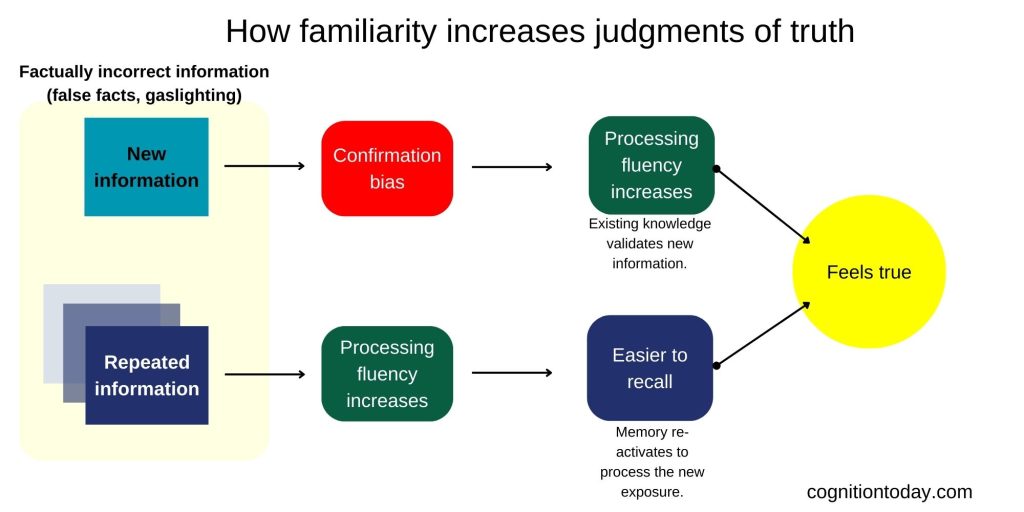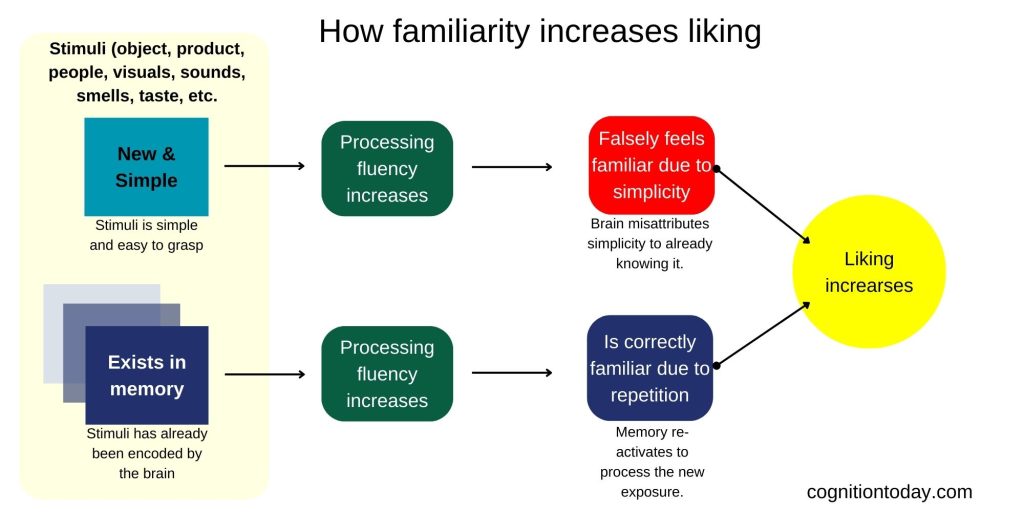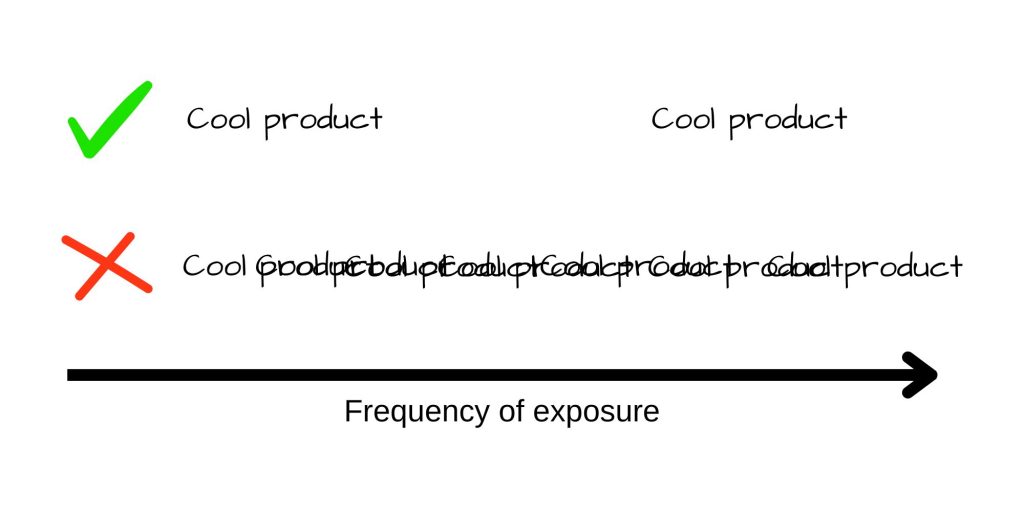What’s common between gaslighting, liking a product, remembering song lyrics, and falling for pseudoscience? A core mechanism of how we perceive the world and form judgments is the common link – repetition.
2 common effects emerge from repetition: the illusory truth effect & the mere exposure effect. They caption the power of repetition over our thoughts, emotions, and preferences.
Imagine this. You see a person at your regular hangout spot but never speak to them. Over time, you stop seeing them as a stranger and start liking them (sometimes, even romantically!). Repetition.
Also, imagine this. You grow up hearing carrots improve your eyesight. Now, you feel it is obvious and intuitive (for no reason you've investigated). You believe in it. Because, Repetition.
Even when a person gaslights someone - convincing them of a false reality. Imagine someone repeatedly saying "It's all in your head". You start to believe it and question your perception. Because, again, Repetition.
In all 3 cases, the stimuli are repeated. The stimuli here are seeing a person, listening to a fact, and hearing “it’s all in your head.” The stimuli can be anything: a song, a product in an advertisement, a food item, a location, or anything else in this universe.
Let’s look at the 2 effects I spoke of, they describe 2 different effects of repetition.
1. The illusory truth effect
Repeated information is judged to be more true than fresh information. This “illusory truth” effect is one of the main reasons fake news and misinformation spreads.
The illusory truth effect states if something is repeated a lot, it feels true and becomes more acceptable. Regularly reading a false fact can make you accept it as the truth without verifying it. It’s one of the reasons why psychological myths like “learning styles” and being left/right-brained[1] have survived for so long. They are repeated so often on the internet that they just seem true now.
Gaslighting: A partner repeats a false statement over and over again till the partner starts believing it.
Misinformation & fake news: Misinformation is repeatedly shared on social media till it becomes familiar. And, people, when trying to recall, recall the misinformation as the truth.
False Narratives & Propaganda: A social or political narrative is rewritten by repeating a new story in newspapers, media, social media, and publications. Then, everyday conversations include that newly re-written narrative which feels like the standard narrative.
Researchers presented participants[2] with trivia statements like ” and repeated them 1 to 27 times and then asked participants to judge their truthfulness after a week. They found that statements that were repeated more often a week ago were perceived to be more true than those that were repeated less. The biggest jump in truthfulness of a statement occurred at the second repetition. This has an implication for gaining information from social media. If you see something once, you judge it for what it is. If you see it twice, you are likely to start thinking it is true.
The illusory truth effect is quite dangerous because it occurs with statements that seem outlandish or outright wrong. Researchers presented outlandish statements[3] like “The tallest person in the world is 35 feet tall” and believable statements like “Baghdad is the capital of Iran” to participants. They showed the illusory truth effect occurs just as strongly for outlandish statements as it does for believable statements. They also noticed that uncertain believable statements create a stronger truthfulness effect with repetition. In their study, extremely implausible statements like “the earth is a perfect square” did not show an observable increase in their truthfulness after repetition, but it is likely there is a small gain in their believability.
The mechanism here is that repetition increases processing fluency and creates familiarity. But it also creates a stronger memory. When we get exposed to information, we tend to accept it if it fits our memory or matches it. Like it is a confirmation bias. The newest repetition of something is validated by our memory of the same thing.
Example: You may repeatedly hear that watching TV from up close will damage your eyes as you grow up. The repetition makes you more likely to believe it. Or you may hear a compatible fact looking at your phone can strain your eyes. And since phones are held much closer to the face, the same effect should occur for TVs.

2. The mere exposure effect
Repeated exposure to objects or sensations make us like them more. This “mere exposure” effect is why we start favoring brands whose ads we’ve already seen.
The mere exposure effect states that repeated exposure to something makes us like it more. So seeing the same people over and over again, by chance or purpose, can make us like them. Similarly, a car you see frequently can make you want to drive it.
The effect is most pronounced when you are exposed to something without much awareness. So familiarity builds up with very little conscious experience. Researchers showed shapes to participants for either 5 milliseconds or 500 milliseconds[4]. 5 milliseconds is such a small duration that humans can’t consciously say they have experienced seeing it. It is subliminal. 500 milliseconds is long enough to perceive a visual shape. The study showed the subliminally shown shapes (5ms) were liked better as they were exposed more times compared to supraliminal shapes (500ms).
A study analyzed multiple other studies looking at the effect of exposure on liking and gives us 2 practical insights.[5]
- Liking will increase with exposure, but only to a point. Then it may get disliked.
- Liking increases more for visual details but may not increase for auditory details.
How does this happen? Researchers have found that repetition increases “processing fluency” – meaning repetition makes something easier and faster to process. The ease with which we process something makes us like it and accept it. Researchers tested and validated[6] multiple mechanisms using music, and the chart below shows what they found.

There’s another process that affects liking. As exposure increases, uncertainty about it reduces, at least subjectively. The default response to uncertainty is fear or aversion. So reducing uncertainty through repetition means it is less feared and less disliked. People tend to reject something new just because it is new and unknown. But as it repeats, uncertainty reduces and we start liking it.
Repetition also backfires
Repetition creates predictability. Seeing an ad regularly during a sports match is repeated exposure becoming predictable. At some point, this may get annoying. But in most cases when it is not overexposed, we tend to start liking it. Researchers tested this[7] and found that people like predictable things (that’s the definition of reducing uncertainty) but start disliking or dismissing things when they are overly predictable.
When a stimulus repeats a lot, it creates habituation – we tend to ignore it or completely miss it because it is constantly present. That’s the reason a monotonous task gets boring – it’s highly repetitive. When it comes to monotonous tasks during work, external stimulation like music or multi-tasking actually helps to counter that habituation.
Overexposure creates another contrasting effect. The stimuli feel meaningless and wrong. I’ve explained it in depth in this article but here’s the gist: Every exposure to something fires up a neural circuit. Too much exposure increases that firing to the point the circuit stops responding to the stimuli. It becomes numb to the stimuli. When it gets numb, there is very little signal coming from the circuit to other areas of the brain. The lack of signal is interpreted as finding it meaningless or wrong. Researchers have dubbed this “reactive inhibition”. You’ve probably experienced its common form – typing a word over and over makes you question its spelling, even if you know the word inside out. That is a special case of reactive inhibition called “semantic satiation“.
So far, we’ve looked at repeated exposure to neutral things like strangers and unknown products. Repetition for neutral things tends to make them more likable and believable. But when repeatedly viewing the same emotional stimuli[8] (things that evoke a positive or negative reaction in an instant), such as photos of happy people, flowers, or negative things like rotting corpses, our emotional reaction becomes weaker and weaker as the repetitions increase. That is, we get numb or desensitized to the emotional stimuli. There are expectations. But they are due to more complex feelings like considering the emotional stimuli as a reward. For example, people won’t find cattos and doggos less cute because they keep looking at them. The cuteness amplifies as they keep thinking about the cuteness. So if repetition engages attention and motivation, the emotional reactions might not dilute.
How else is repetition used in society?
Repetition works because it became a mechanism for learning, given to us by evolution. And we’ve repurposed it in many different ways. Any kind of communication is, in some essence, a nano-learning process. Telling someone about something, persuading others, bring someone’s attention to something, is all about that nano-learning process between the communicator and the listener. So, repetition has taken unique forms as a tool in society. This is where you’ve most likely seen it.
Political campaigns: Drive narratives, make constituents remember something a certain way (via slogans, repetition of keywords, branding, etc.)
Studying & memorizing: Repeated recall strengthens memory by reinforcing the neural pathways that represent the memory. Systematically spacing repetition also delays forgetting. More here.
Habit formation: Repeating an action makes it automatic and feel natural. After multiple repetitions, the action does not require thinking and gets initiated with very little effort. More here.
Advertising: Grab attention.
Giving speeches: Reinforce a point so the audience doesn’t lose track of the core message.
Audio & subtitles: Auditory information and subtitles act as instantaneous repetitions, making the combination of the 2 easier to process than just audio or just subtitles. More here.
Special tip for marketers & advertisers
How can you leverage repetition for effective marketing? The formula is easy – repeat short chunks of information, tastefully. Focus on processing fluency by making it easy to read, recognize, and recall. This increases memory for the product and liking for the brand. Avoid repeating so much that it numbs the audience.

Sources
[2]: https://cognitiveresearchjournal.springeropen.com/articles/10.1186/s41235-021-00301-5?ref=paradoxpairs.com
[3]: https://link.springer.com/article/10.3758/s13423-019-01651-4
[4]: https://psycnet.apa.org/record/1993-04248-001
[5]: https://psycnet.apa.org/record/2017-10109-001
[6]: https://psycnet.apa.org/record/2019-38985-010
[7]: https://www.sciencedirect.com/science/article/abs/pii/S0001691816300919
[8]: https://onlinelibrary.wiley.com/doi/abs/10.1111/j.1469-8986.2010.01083.x

Hey! Thank you for reading; hope you enjoyed the article. I run Cognition Today to capture some of the most fascinating mechanisms that guide our lives. My content here is referenced and featured in NY Times, Forbes, CNET, and Entrepreneur, and many other books & research papers.
I’m am a psychology SME consultant in EdTech with a focus on AI cognition and Behavioral Engineering. I’m affiliated to myelin, an EdTech company in India as well.
I’ve studied at NIMHANS Bangalore (positive psychology), Savitribai Phule Pune University (clinical psychology), Fergusson College (BA psych), and affiliated with IIM Ahmedabad (marketing psychology). I’m currently studying Korean at Seoul National University.
I’m based in Pune, India but living in Seoul, S. Korea. Love Sci-fi, horror media; Love rock, metal, synthwave, and K-pop music; can’t whistle; can play 2 guitars at a time.



























